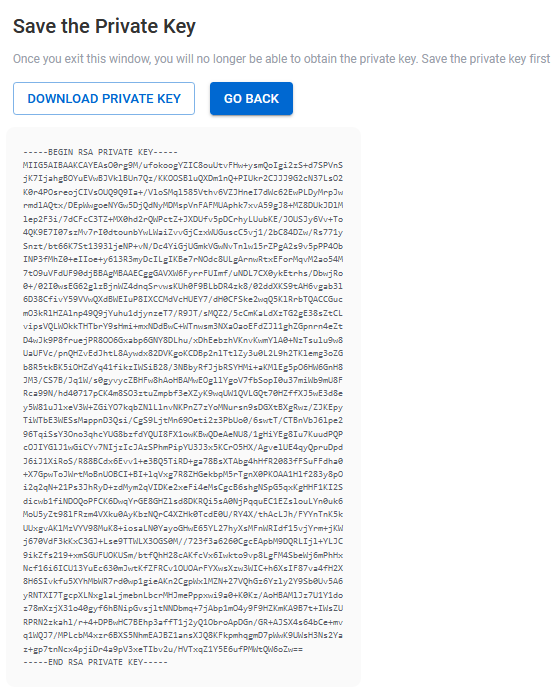Getting Started
Before jumping any further, please check out the installation process to deploy all Lamassu services. This section will guide you through the basic functionalities provided by our PKI to start provisioning your devices.
Overview
Create a new Certification Authority
The first step to provision your devices with digital certificates is to create the Certification Authority. The role of a CA is to issue and manage all the certificates. To create a new CA, fill the following form taking into account the following things:
- Lamassu supports both
RSAandECbased CAs. - The CA name MUST be unique.
- The CA expiration time must be greater than the lifespan of the issued certs.
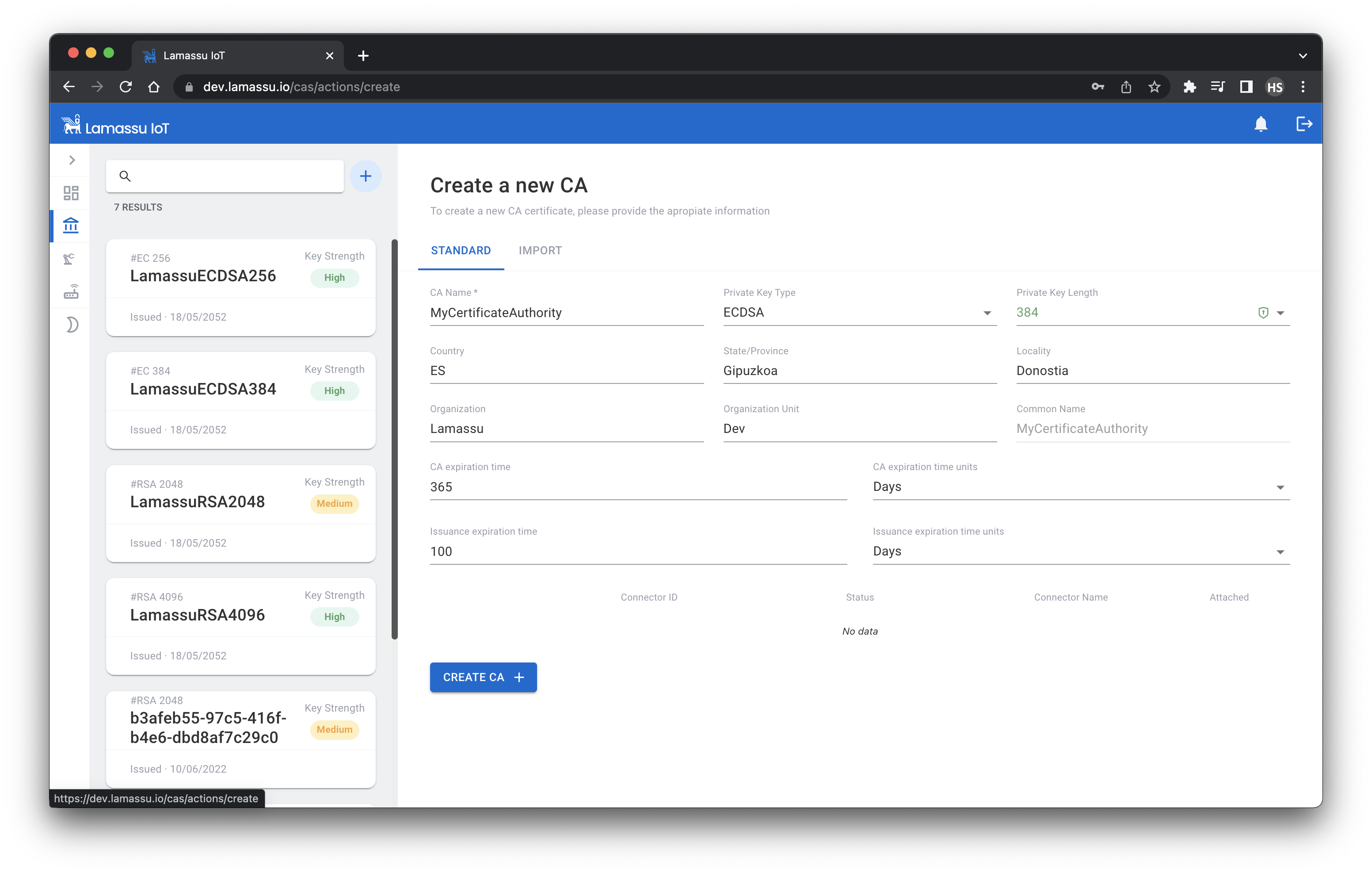
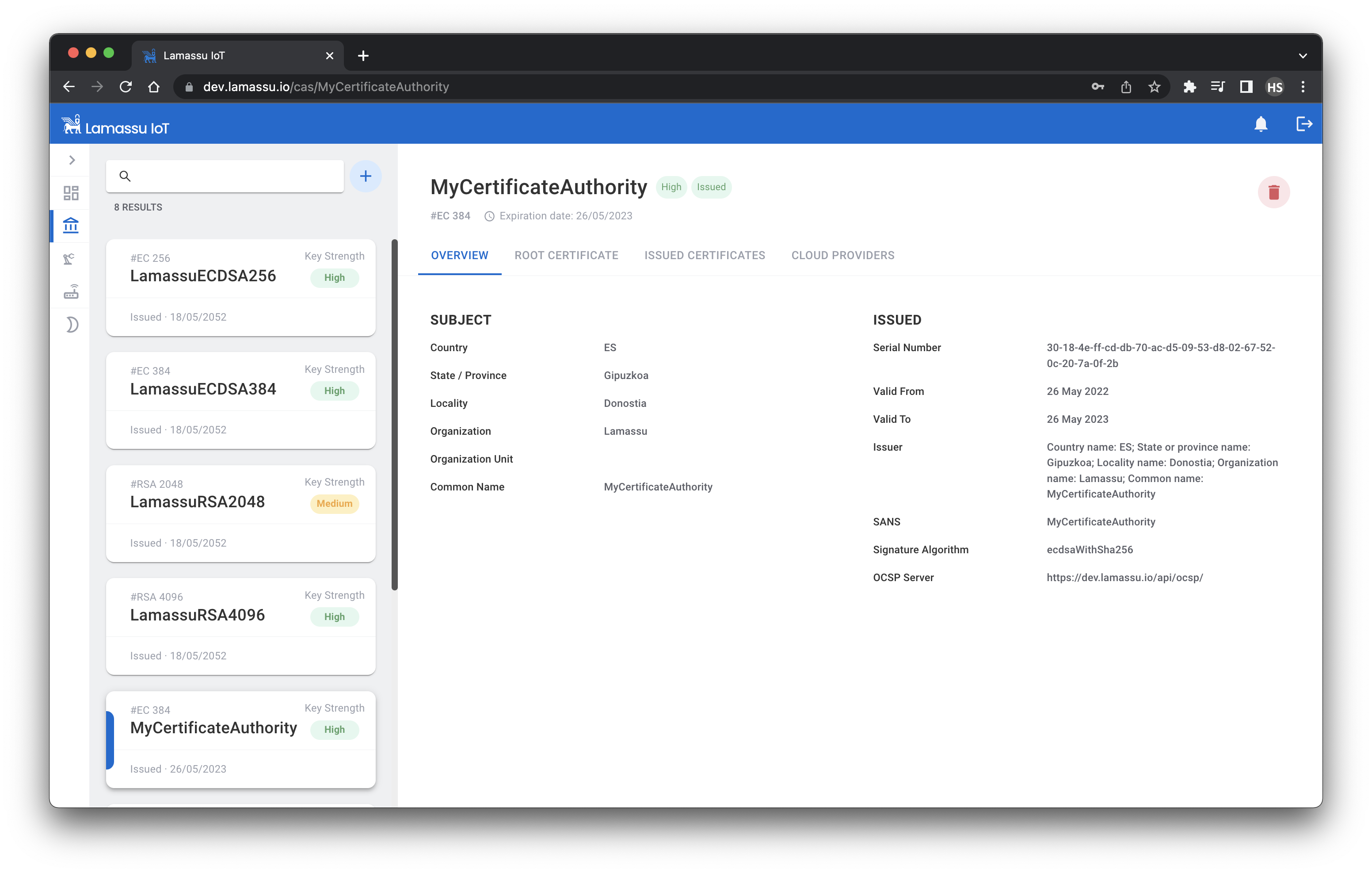
Register a new Device Manufacturing System
Lamassu is a PKI designed for the industrial and IoT sector. To better integrate this PKI in real life manufacturing system, Lamassu delegates the issuance of device certificate to the factory itself. First lets dive into the Device Manufacturing System (DMS for short) registration step by step. After that, a couple of examples will demonstrate how to start enrolling your devices using the Lamassu's Virtual DMS software as well as using the UI.
Device manufacturing process tend to be highly automated. Provisioning the devices with digital identities should not slow down the fabrication process. Lamassu addresses this challenge introducing the DMS concept as core.
One of the factories operators stars the process by generating a DMS registration request contained in a Certificate Signing Request also referred as CSR. This CSR is then sent to the DMS Enroller service to be approved by one of the PKI Administrators:
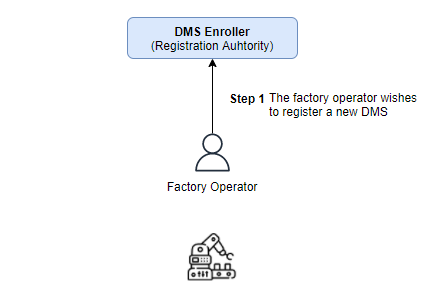
The Administrator then decides if the request is approved or denied. If it decision is to approve the DMS registration request, the Administrator must specify which CAs will that particular DSM be entitled to issue certificates with:
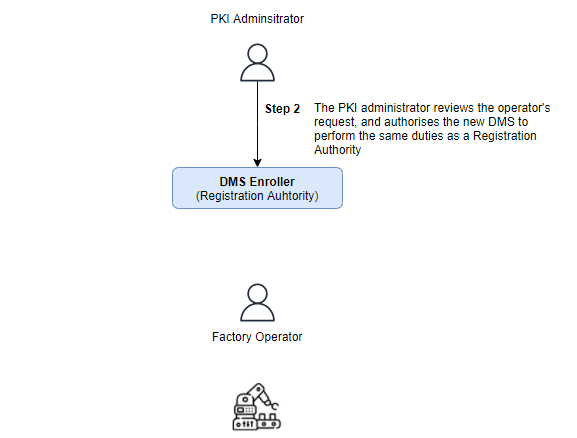
Once, and only if, the DMS registration request is approved, then the Operator must retrieve the signed CSR and pass it to the DMS software that will be in charge off requesting the issuance of new digital certificates for the manufactured devices:
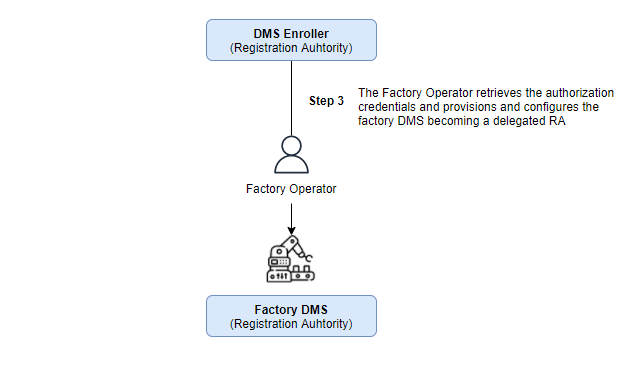
Finally, the DMS is able to request new x509 certificates for its manufactured devices. The DMS may be assisted by additional tools to obtain the manufactured device unique identifier.
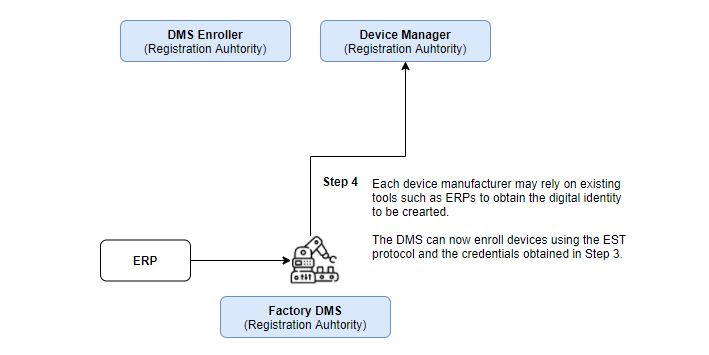
!!! note Envoy is used as an API gateway in this project. Currently Envoy is written to use Boring SSl as the TLS provider. It does not support secp224r1 signing method, which is used to create ECDSA224 keys. Therefore, enroll and reenroll methods will return a error when using this key.
Let's register a new DMS instance:
Manual DMS
- Operator - Authenticate the user:
OPERATOR_USERNAME=operator
OPERATOR_PASSWORD=operator
DOMAIN=dev.lamassu.io
OPERATOR_TOKEN=$(curl -k -s --location --request POST "https://auth.$DOMAIN/auth/realms/lamassu/protocol/openid-connect/token" --header 'Content-Type: application/x-www-form-urlencoded' --data-urlencode 'grant_type=password' --data-urlencode 'client_id=frontend' --data-urlencode "username=$OPERATOR_USERNAME" --data-urlencode "password=$OPERATOR_PASSWORD" | jq -r .access_token)
- Operator - Request the registration for a new DMS instance:
DMS_NAME=MyDMS
DMS_SUBJECT_COUNTRY=ES
DMS_SUBJECT_STATE=Gipuzkoa
DMS_SUBJECT_LOCALITY=Donostia
DMS_SUBJECT_ORGANIZATION=Lamassu
DMS_SUBJECT_ORGANIZATION_UNIT=IoT
DMS_REG_RESPONSE=$(curl -k --location --request POST "https://$DOMAIN/api/dmsmanager/v1/" \
--header "Authorization: Bearer $OPERATOR_TOKEN" \
--data-raw "{\"key_metadata\": {\"bits\":3072, \"type\":\"RSA\"}, \"subject\":{\"common_name\":\"$DMS_NAME\", \"country\":\"$DMS_SUBJECT_COUNTRY\",\"locality\":\"$DMS_SUBJECT_LOCALITY\",\"organization\":\"$DMS_SUBJECT_ORGANIZATION\",\"organization_unit\":\"$DMS_SUBJECT_ORGANIZATION_UNIT\",\"state\":\"$DMS_SUBJECT_STATE\"}}")
DMS_NAME=$(echo $DMS_REG_RESPONSE | jq -r .dms.name)
echo $DMS_REG_RESPONSE | jq -r .private_key | base64 -d > dms.key
- Admin - Authenticate the admin user
ENROLLER_USERNAME=enroller
ENROLLER_PASSWORD=enroller
DOMAIN=dev.lamassu.io
ENROLLER_TOKEN=$(curl -k -s --location --request POST "https://auth.$DOMAIN/auth/realms/lamassu/protocol/openid-connect/token" --header 'Content-Type: application/x-www-form-urlencoded' --data-urlencode 'grant_type=password' --data-urlencode 'client_id=frontend' --data-urlencode "username=$ENROLLER_USERNAME" --data-urlencode "password=$ENROLLER_PASSWORD" | jq -r .access_token)
- Admin - Authorize the enrollment with all the provisioned CAs
AUTHORIZED_CAS=$(curl -k "https://$DOMAIN/api/ca/v1/pki" --header "Authorization: Bearer $ENROLLER_TOKEN" | jq .cas[].name | jq -s)
curl -k --location --request PUT "https://$DOMAIN/api/dmsmanager/v1/$DMS_NAME/status" \
--header "Authorization: Bearer $ENROLLER_TOKEN" \
--data-raw "{\"status\":\"APPROVED\"}"
curl -k --location --request PUT "https://$DOMAIN/api/dmsmanager/v1/$DMS_NAME/auth" \
--header "Authorization: Bearer $ENROLLER_TOKEN" \
--data-raw "{\"authorized_cas\":$AUTHORIZED_CAS}"
- Operator - Get the DMS certificate:
curl -k "https://$DOMAIN/api/dmsmanager/v1/$DMS_NAME" --header "Authorization: Bearer $OPERATOR_TOKEN" | jq -r .certificate | base64 -d > dms.crt
Cloud Hosted DMS
When creating a Cloud Hosted DMS the Payload of the request has three more parameters:
- BootstrapCAs: Bootstrap CAs, i.e. the Bootstrap certificate used by the device has to be issued by one of these CAs, in case it is not issued by any of these CAs the device request will not be authorized.
- IsCloudDMS: It is a boolean parameter. In this case it always has the same value true.
Let's register a new Cloud Hosted DMS instance:
- Operator - Authenticate the user:
OPERATOR_USERNAME=operator
OPERATOR_PASSWORD=operator
DOMAIN=dev.lamassu.io
OPERATOR_TOKEN=$(curl -k -s --location --request POST "https://auth.$DOMAIN/auth/realms/lamassu/protocol/openid-connect/token" --header 'Content-Type: application/x-www-form-urlencoded' --data-urlencode 'grant_type=password' --data-urlencode 'client_id=frontend' --data-urlencode "username=$OPERATOR_USERNAME" --data-urlencode "password=$OPERATOR_PASSWORD" | jq -r .access_token)
- Admin - Authenticate the admin user
ENROLLER_USERNAME=enroller
ENROLLER_PASSWORD=enroller
DOMAIN=dev.lamassu.io
ENROLLER_TOKEN=$(curl -k -s --location --request POST "https://auth.$DOMAIN/auth/realms/lamassu/protocol/openid-connect/token" --header 'Content-Type: application/x-www-form-urlencoded' --data-urlencode 'grant_type=password' --data-urlencode 'client_id=frontend' --data-urlencode "username=$ENROLLER_USERNAME" --data-urlencode "password=$ENROLLER_PASSWORD" | jq -r .access_token)
- Admin - Get all the provisioned CAs
CAS=$(curl -k "https://$DOMAIN/api/ca/v1/pki" --header "Authorization: Bearer $ENROLLER_TOKEN" | jq .cas[].name | jq -s)
- Operator - Request the registration for a new DMS instance:
DMS_NAME=HostCloudDMS
DMS_SUBJECT_COUNTRY=ES
DMS_SUBJECT_STATE=Gipuzkoa
DMS_SUBJECT_LOCALITY=Donostia
DMS_SUBJECT_ORGANIZATION=Lamassu
DMS_SUBJECT_ORGANIZATION_UNIT=IoT
DMS_REG_RESPONSE=$(curl -k --location --request POST "https://$DOMAIN/api/dmsmanager/v1/" \
--header "Authorization: Bearer $OPERATOR_TOKEN" \
--data-raw "{\"key_metadata\": {\"bits\":3072, \"type\":\"RSA\"}, \"subject\":{\"common_name\":\"$DMS_NAME\", \"country\":\"$DMS_SUBJECT_COUNTRY\",\"locality\":\"$DMS_SUBJECT_LOCALITY\",\"organization\":\"$DMS_SUBJECT_ORGANIZATION\",\"organization_unit\":\"$DMS_SUBJECT_ORGANIZATION_UNIT\",\"state\":\"$DMS_SUBJECT_STATE\"}, \"host_cloud_dms\":true, \"bootstrap_cas\":$CAS }")
DMS_NAME=$(echo $DMS_REG_RESPONSE | jq -r .dms.name)
echo $DMS_REG_RESPONSE | jq -r .private_key | base64 -d > dms.key
- Admin - Authenticate the admin user
ENROLLER_TOKEN=$(curl -k -s --location --request POST "https://auth.$DOMAIN/auth/realms/lamassu/protocol/openid-connect/token" --header 'Content-Type: application/x-www-form-urlencoded' --data-urlencode 'grant_type=password' --data-urlencode 'client_id=frontend' --data-urlencode "username=$ENROLLER_USERNAME" --data-urlencode "password=$ENROLLER_PASSWORD" | jq -r .access_token)
- Admin - Authorize the enrollment with all the provisioned CAs
AUTHORIZED_CAS=$(curl -k "https://$DOMAIN/api/ca/v1/pki" --header "Authorization: Bearer $ENROLLER_TOKEN" | jq .cas[].name | jq -s)
curl -k --location --request PUT "https://$DOMAIN/api/dmsmanager/v1/$DMS_NAME/status" \
--header "Authorization: Bearer $ENROLLER_TOKEN" \
--data-raw "{\"status\":\"APPROVED\"}"
AUTHORIZED_CA=$(echo $AUTHORIZED_CAS | jq .[0] -r)
curl -k --location --request PUT "https://$DOMAIN/api/dmsmanager/v1/$DMS_NAME/auth" \
--header "Authorization: Bearer $ENROLLER_TOKEN" \
--data-raw "{\"authorized_cas\":[\"$AUTHORIZED_CA\"]}"
- Operator - Get the DMS certificate:
curl -k "https://$DOMAIN/api/dmsmanager/v1/$DMS_NAME" --header "Authorization: Bearer $OPERATOR_TOKEN" | jq -r .certificate | base64 -d > dms.crt
Provision your devices with x509 Certificates
The enrollment process is the way to go to obtain a certificate issued by one of the provisioned CAs. As described in the RFC document, Lamassu requires the authentication of the client requesting the enrollment using a certificate as well as the private key of an issued DMS to perform a mutual TLS connection. By using this type of TLS connection, the client is able to authenticate the server, and also, the server is able to authenticate the client.
Although the /api/devmanager/.well-known/cacerts endpoint returns the list
containing all the manged CAs by the PKI, each DMS is entitled to request the
issuance of a certificate with an authorized CA. For instance, the PKI may have
the following CAs: CA1, CA2, CA3 and CA4. The
/api/devmanager/.well-known/cacerts would return all four CAs. Then, a new DMS
is registered. the PKI administrator approves the DMS registration by
authorizing such DMS to issue certificates with CA1 and CA4. This process is
known as the DMS registration process. Once the DMS is completely registered,
it can now start performing the EST enrollment process. Check out the
previous section to understand
what a DMS does.
Let's first obtain the CA list for a particular DMS:
Manual DMS
- First, authenticate and obtain a valid JWT
OPERATOR_USERNAME=operator
OPERATOR_PASSWORD=operator
DOMAIN=dev.lamassu.io
OPERATOR_TOKEN=$(curl -k -s --location --request POST "https://auth.$DOMAIN/auth/realms/lamassu/protocol/openid-connect/token" --header 'Content-Type: application/x-www-form-urlencoded' --data-urlencode 'grant_type=password' --data-urlencode 'client_id=frontend' --data-urlencode "username=$OPERATOR_USERNAME" --data-urlencode "password=$OPERATOR_PASSWORD" | jq -r .access_token)
- Obtain the CA list:
ENTITLED_CAS=$(curl -k --location --request GET "https://$DOMAIN/api/dmsmanager/v1/$DMS_NAME" --header "Authorization: Bearer $OPERATOR_TOKEN" | jq .authorized_cas)
- Select one of the entitled the CAs from the previous list:
!!! note
You can manually spefify the `SELECTED_CA`. Otherwise you can enroll the device with the first entitled CA using the following command.
```
SELECTED_CA=$(echo $ENTITLED_CAS | jq .[0] -r)
```
- Generate the device CSR:
DEVICE_ID=mytestdevice-123
openssl req -new -newkey rsa:2048 -nodes -keyout device.key -out device.csr -outform DER -subj "/CN=$DEVICE_ID"
openssl base64 -in device.csr -out device.b64 -e
- Enroll the device:
DMS_CRT_PATH=path/to/dms_crt
DMS_KEY_PATH=path/to/dms_key
openssl s_client -connect $DOMAIN:443 2>/dev/null </dev/null | sed -ne '/-BEGIN CERTIFICATE-/,/-END CERTIFICATE-/p' > root-ca.pem
curl https://$DOMAIN/api/devmanager/.well-known/est/$SELECTED_CA/simpleenroll --cert $DMS_CRT_PATH --key $DMS_KEY_PATH -s -o device-cert.p7 --cacert root-ca.pem --data @device.b64 -H "Content-Type: application/pkcs10" -H "Content-Transfer-Encoding: base64"
openssl base64 -d -in device-cert.p7 | openssl pkcs7 -inform DER -outform PEM -print_certs -out device-cert.pem
openssl x509 -text -in device-cert.pem
Cloud Hosted DMS
- First, authenticate and obtain a valid JWT
ENROLLER_USERNAME=enroller
ENROLLER_PASSWORD=enroller
DOMAIN=dev.lamassu.io
ENROLLER_TOKEN=$(curl -k -s --location --request POST "https://auth.$DOMAIN/auth/realms/lamassu/protocol/openid-connect/token" --header 'Content-Type: application/x-www-form-urlencoded' --data-urlencode 'grant_type=password' --data-urlencode 'client_id=frontend' --data-urlencode "username=$ENROLLER_USERNAME" --data-urlencode "password=$ENROLLER_PASSWORD" | jq -r .access_token)
- Obtain the Bootstrap CA list:
ENTITLED_CAS=$(curl -k --location --request GET "https://$DOMAIN/api/dmsmanager/v1/$DMS_NAME" --header "Authorization: Bearer $OPERATOR_TOKEN" | jq .bootstrap_cas)
- Select one of the entitled the CAs from the previous list:
!!! note
You can manually spefify the `BOOTSTRAP_CA`.
```
BOOTSTRAP_CA=$(echo $ENTITLED_CAS | jq .[0] -r)
```
- Generate the Bootstrap CSR:
DEVICE_ID=bootstrap
openssl req -new -newkey rsa:2048 -nodes -keyout bootstrap.key -out bootstrap.csr -subj "/CN=$DEVICE_ID"
- Admin - Authenticate the admin user
```
ENROLLER_TOKEN=$(curl -k -s --location --request POST "https://auth.$DOMAIN/auth/realms/lamassu/protocol/openid-connect/token" --header 'Content-Type: application/x-www-form-urlencoded' --data-urlencode 'grant_type=password' --data-urlencode 'client_id=frontend' --data-urlencode "username=$ENROLLER_USERNAME" --data-urlencode "password=$ENROLLER_PASSWORD" | jq -r .access_token)
```
- Admin - Get Bootstrap Certificate
openssl s_client -connect $DOMAIN:443 2>/dev/null </dev/null | sed -ne '/-BEGIN CERTIFICATE-/,/-END CERTIFICATE-/p' > root-ca.pem
CSR_B64=$(openssl base64 -in bootstrap.csr -e | tr -d [:space:])
BOOTSTRAP_CERT=$(curl -k --location --request POST "https://$DOMAIN/api/ca/v1/pki/$BOOTSTRAP_CA/sign" --header "Authorization: Bearer $ENROLLER_TOKEN" --data-raw "{\"certificate_request\":\"$CSR_B64\", \"common_name\":\"bootstrap\",\"sign_verbatim\":true}")
echo $BOOTSTRAP_CERT | jq -r .certificate | base64 -d > bootstrap.crt
- Enroll the device:
DEVICE_ID=mytestdevice-123
openssl req -new -newkey rsa:2048 -nodes -keyout device.key -out device.csr -outform DER -subj "/CN=$DEVICE_ID"
openssl base64 -in device.csr -out device.b64 -e
BOOTSTRAP_CRT_PATH=path/to/bootstrap_crt
BOOTSTRAP_KEY_PATH=path/to/bootstrap_key
openssl s_client -connect $DOMAIN:443 2>/dev/null </dev/null | sed -ne '/-BEGIN CERTIFICATE-/,/-END CERTIFICATE-/p' > root-ca.pem
curl https://$DOMAIN/api/dmsmanager/.well-known/est/$DMS_NAME/simpleenroll --cert $BOOTSTRAP_CRT_PATH --key $BOOTSTRAP_KEY_PATH -s -o device-cert.p7 --cacert root-ca.pem --data @device.b64 -H "Content-Type: application/pkcs10" -H "Content-Transfer-Encoding: base64"
openssl base64 -d -in device-cert.p7 | openssl pkcs7 -inform DER -outform PEM -print_certs -out device-cert.pem
openssl x509 -text -in device-cert.pem
Using the UI
The UI is an easy manageable tool designed to ease the burdens to non-technical users in using Lamassu PKI. This project was bootstrapped with Create React App.
You can learn more in the Create React App documentation.
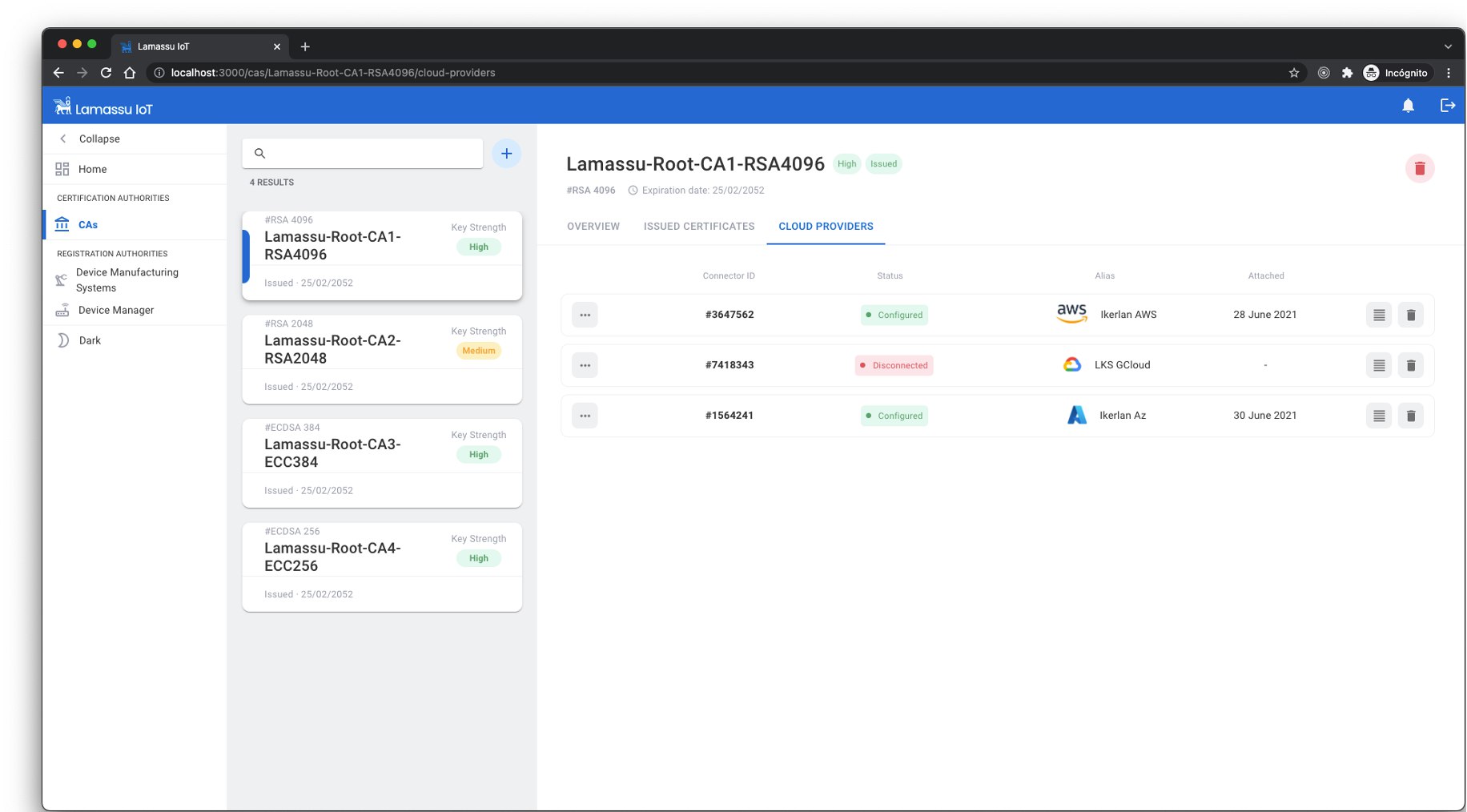
Deployment
This section has moved here: https://facebook.github.io/create-react-app/docs/deployment
Create a new Certification Authority
There are two methos of creating a new CA from the UI.
The first one, filling the following form taking into account the following things:
- Lamassu supports both
RSAandECbased CAs. - The CA name MUST be unique.
- The CA expiration time must be greater than the lifespan of the issued certs.


The other one, will be importing it. A Certificate and a Private Key will be required.
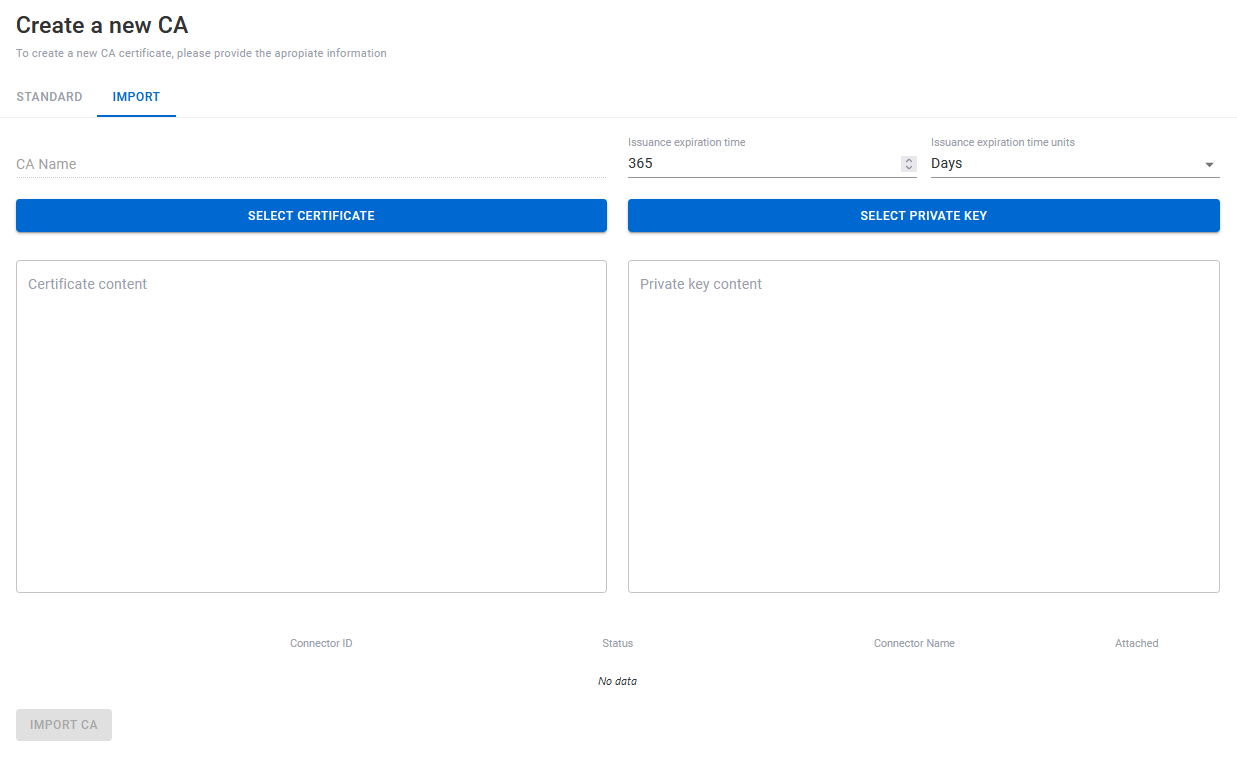
Registration of a DMS using the UI
Using the UI, creating a new DMS is as simple as filling the following form.
Manual DMS
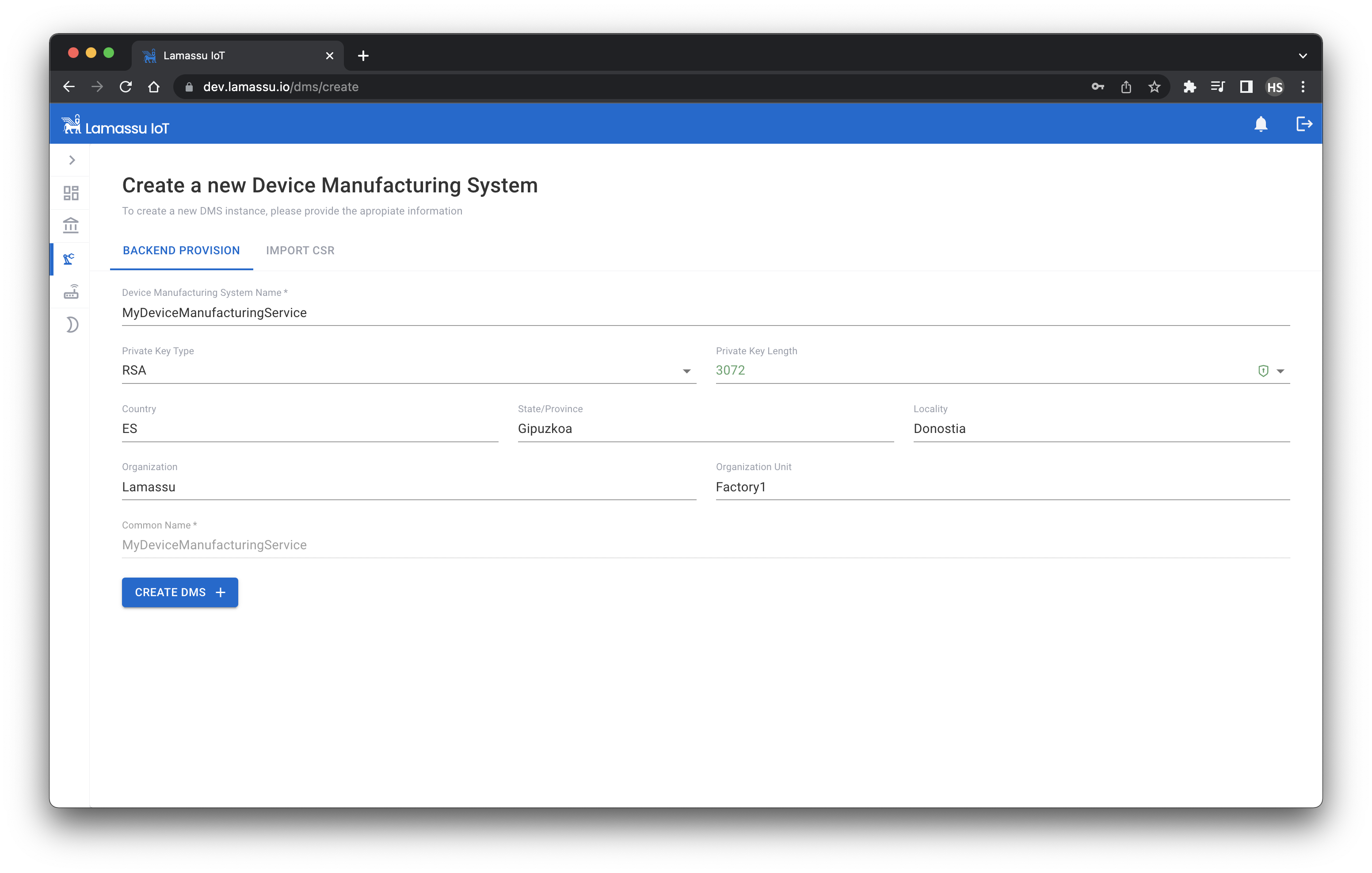
Cloud Hosted DMS
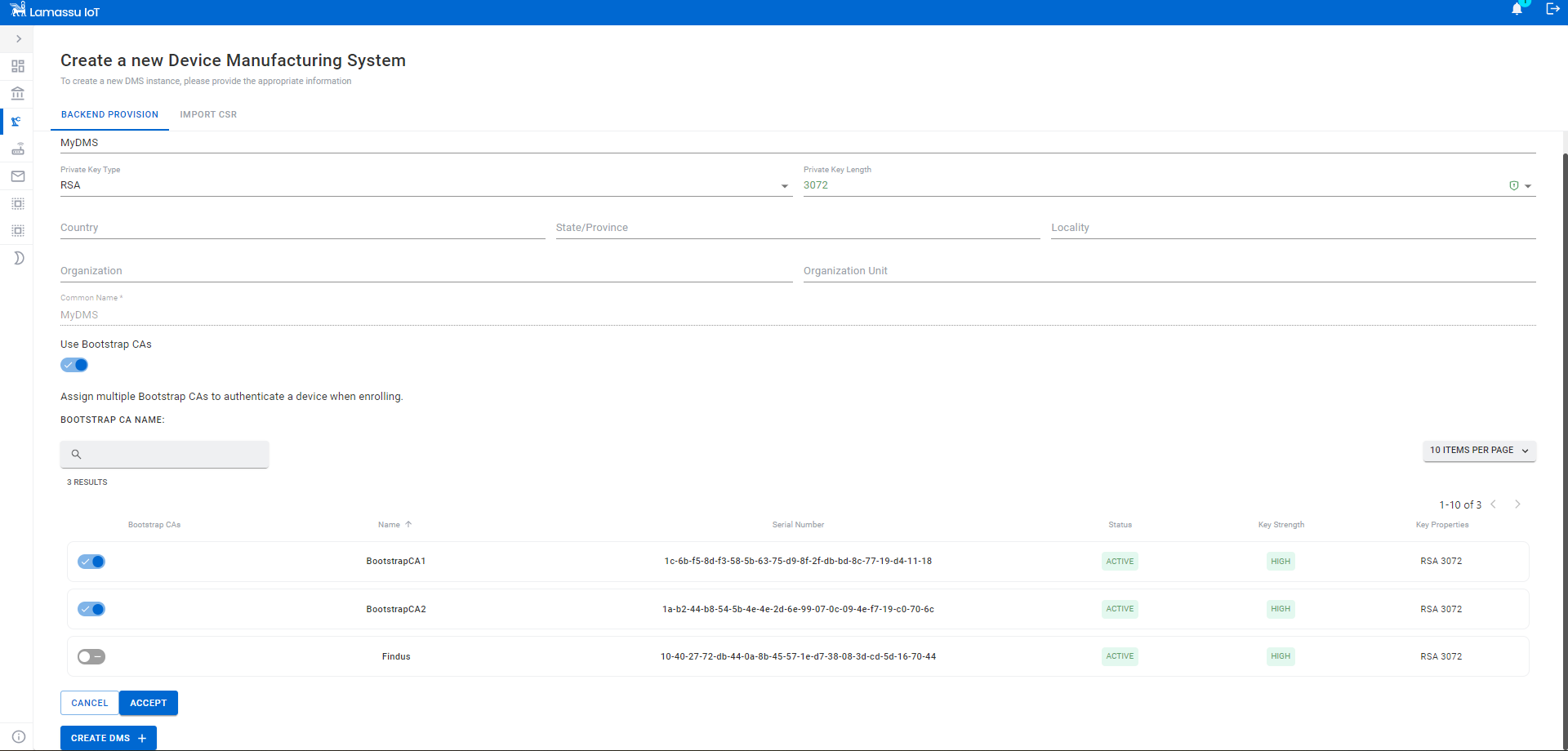
Once the DMS has been created successfully, a prompt showing the generated private key will be shown. It is encouraged to download it just after the creation as this prompt will be shown only once.
The status of the new created DMS will be Pending Approval, to approve it, we
must select at least one CA from the list of registered CAs. The selected CAs
will be the authorised ones to sign certificates from now on.
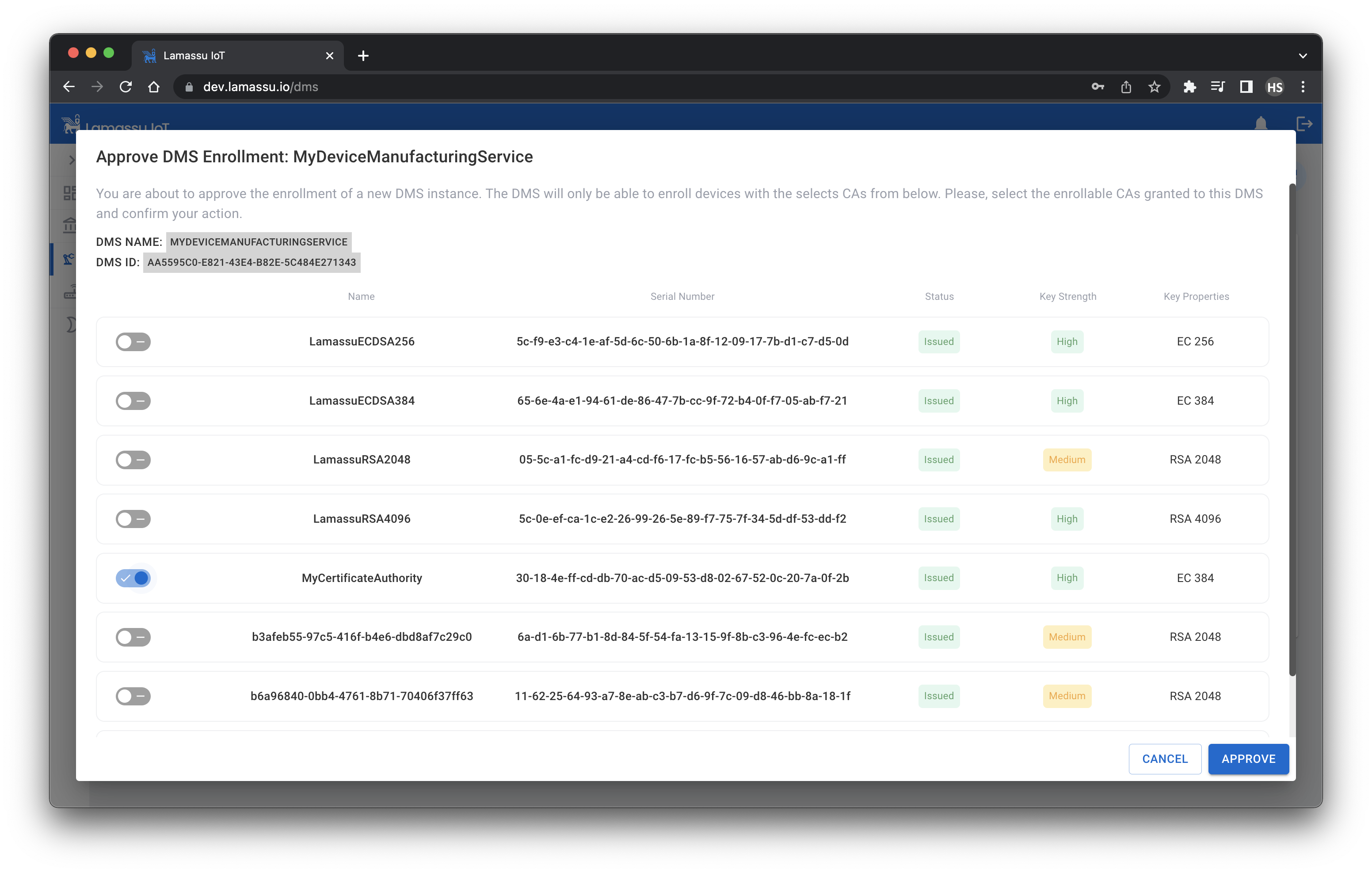
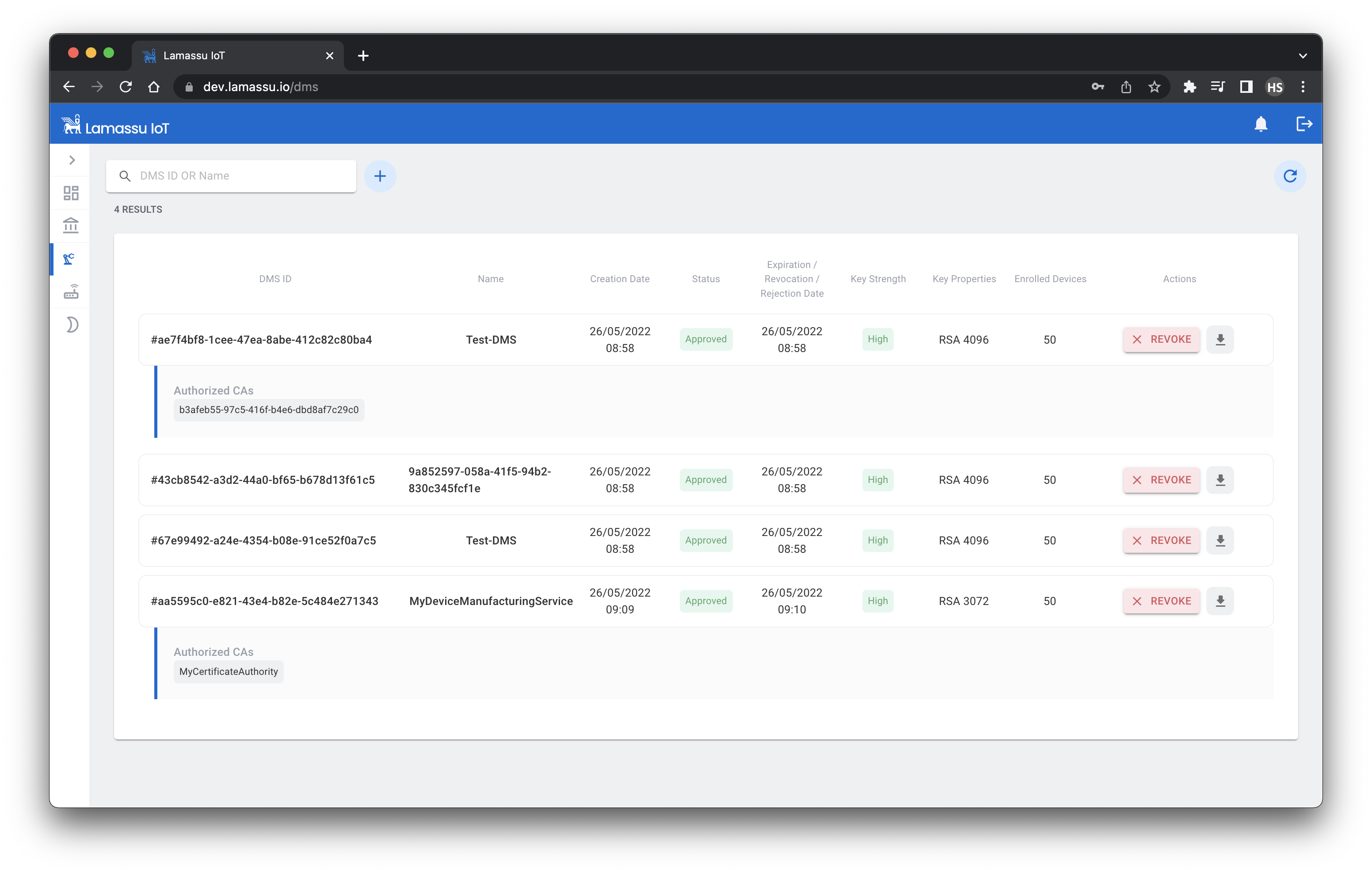
Registration of a device using the UI
To create a device, we will need to fill the following form taking into account:
- A device identification must be provided.
- A DMS must be assigned.
Each device can have certificates signed by different authorised CAs.

The certificates of each device as well as the cloud-connectors will be showned.
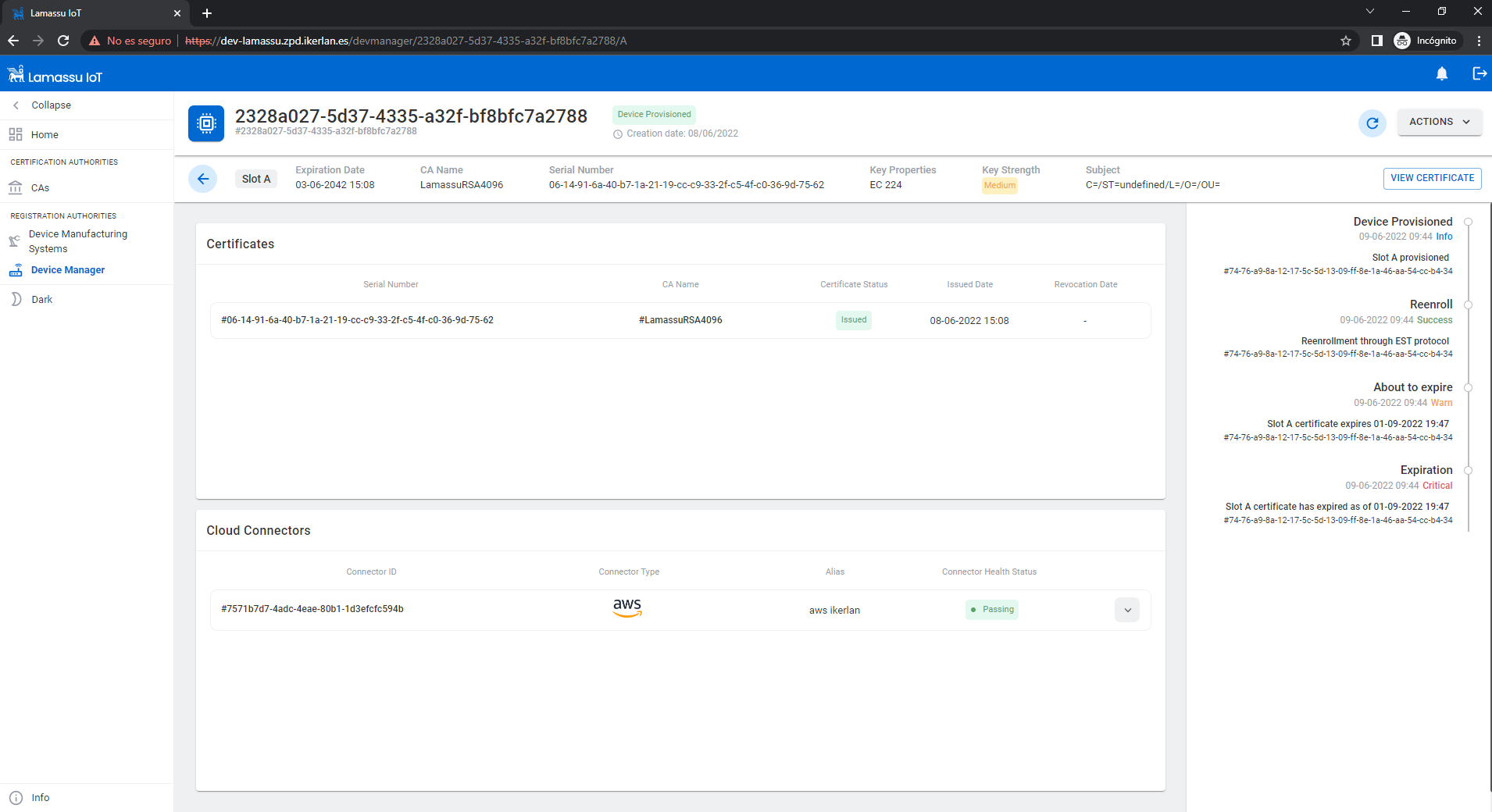
Using the APIs
The main 3 Open API documentation can be found on the following urls:
- https://dev.lamassu.io/api/dmsmanager/v1/docs/
- https://dev.lamassu.io/api/ca/v1/docs/
- https://dev.lamassu.io/api/devmanager/v1/docs/
Note
The following endpoints defined in the Lamassu Device Manager Api specification are not correctly defined due to the limitations imposed by the Open API 3.0 schema. The current specification defines an `OIDC` security schema (meaning that a valid JWT token must be provided while requesting the API) while the implemented security schema uses the `mTLS` approach. This issue will be resolved once the specification is migrated to Open API 3.1 compliant. The affected endpoints are:

Lamassu provides easy to use GO clients for most of its APIs to help speeding up
the development of third-party applications. Before using thees clients, it is
important to identify the path taken by the request. Unless the application
using the GO clients (or any other http client such as curl) is deployed
within the same docker network, the request will be
handled by the API Gateway component. Otherwise
check the internal usage section.
Through the API Gateway
``` go
package main
import (
"net/url"
lamassuCAClient "github.com/lamassuiot/lamassuiot/pkg/ca/client"
caDTO "github.com/lamassuiot/lamassuiot/pkg/ca/common/dto"
"github.com/lamassuiot/lamassuiot/pkg/utils/client"
)
function main (){
lamassuGatewayURL := "dev.lamassu.io"
apiCAFile := "path/to/apigw.crt"
caClient := lamassuCAClient.NewLamassuCAClient(client.ClientConfiguration{
URL: &url.URL{
Scheme: "https",
Host: lamassuGatewayURL,
Path: "/api/ca/",
},
AuthMethod: client.JWT,
AuthMethodConfig: &client.JWTConfig{
Username: "enroller",
Password: "enroller",
URL: &url.URL{
Scheme: "https",
Host: "auth." + lamassuGatewayURL,
},
CACertificate: apiCAFile,
},
CACertificate: apiCAFile,
})
ca, err = caClient.CreateCA(context.Background(), caDTO.Pki, caName, caDTO.PrivateKeyMetadata{KeyType: "rsa", KeyBits: 2048}, caDTO.Subject{CN: caName}, 365*time.Hour, 30*time.Hour)
}
```
=== "Curl" Define the DOMAIN, TOKEN and CA_NAME
export AUTH_ADDR=auth.$DOMAIN export TOKEN=$(curl -k --location --request POST "https://$AUTH_ADDR/auth/realms/lamassu/protocol/openid-connect/token" --header 'Content-Type: application/x-www-form-urlencoded' --data-urlencode 'grant_type=password' --data-urlencode 'client_id=frontend' --data-urlencode 'username=enroller' --data-urlencode 'password=enroller' | jq -r .access_token) export CA_ADDR=$DOMAIN/api/ca export CA_NAME=$(uuidgen)
Creting CA
export CREATE_CA_RESP=$(curl -k -s --location --request POST "https://$CA_ADDR/v1/pki" --header "Authorization: Bearer ${TOKEN}" --header 'Content-Type: application/json' --data-raw "{\"ca_duration\": 262800, \"issuance_duration\": 175200, \"subject\":{ \"common_name\": \"$CA_NAME\",\"country\": \"ES\",\"locality\": \"Arrasate\",\"organization\": \"LKS Next, S. Coop\",\"state\": \"Gipuzkoa\"},\"key_metadata\":{\"bits\": 4096,\"type\": \"RSA\"}}")
Running Unit tests
#For pretty printing
go install github.com/haveyoudebuggedit/gotestfmt/v2/cmd/gotestfmt@v2.3.1
go test -json -v ./pkg/ca/server/api/ | gotestfmt
go test -json -v ./pkg/dms-manager/server/api/ | gotestfmt
go test -json -v ./pkg/device-manager/server/api/ | gotestfmt
Filtering, Sorting and Pagination
Lamassu API supports filtering, sorting and pagination.
The filter can be form by the following parameters, being each of them optional:
filter= attribute[operator]=valuesort_by=attribute.[asc|desc]limit=value. Limits the maximun number of results of the queryoffset=value. In addition tolimit, implements pagination. It defines the index of the first value from the resulting query.
Example
```
/v1/devices?filter=id[contains]=device_id&sort_by=id.asc&limit=100&offset=15
/v1?filter=id[contains]=dms_id&sort_by=id.desc
```
Operators
Depending of the data type of the parameters, the supported operators will vary.
- Strings :
equals,notequals,contains,notcontains - Dates:
before,after,is,isnot - Enums:
is,isnot - Numbers:
lessthan,greaterthan,lessorequal,gretaerorequal,equal,notequal
